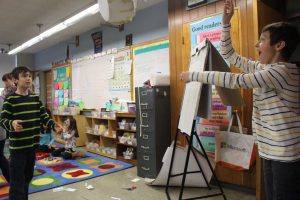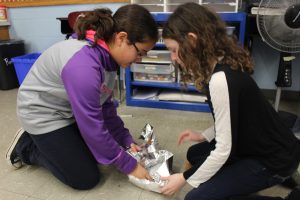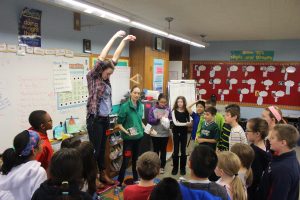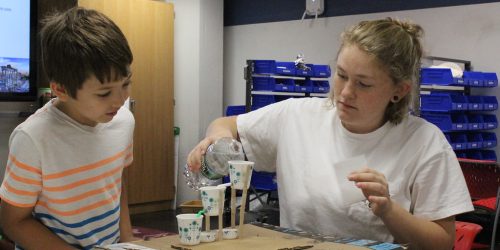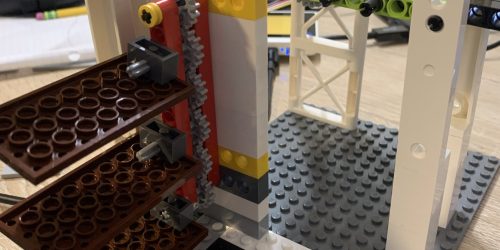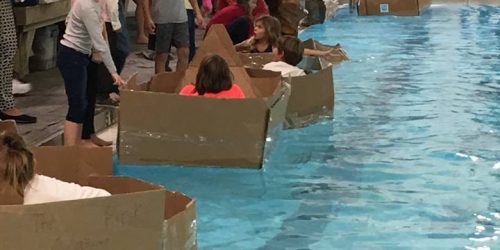By Laura Fradin, CEEO STOMP Fellow
5th grade classroom at Norcross Elementary School in Arlington, Massachusetts
One of the biggest obstacles for STOMPers is creating a cohesive unit throughout the semester. Many STOMPers choose to do an “Introduction to Engineering” unit that introduces civil, mechanical, chemical, aerospace, environmental, and other types of engineering into a single semester. While this approach is fun and effective, it sometimes lacks continuity between lessons. I spent a while brainstorming ways to introduce multiple types of engineering while maintaining a central theme and came up with the idea of incorporating something students already like with activities from the STOMP activity database. Superhero movies and television shows have grown increasingly popular in the last few years so I decided to structure a semester’s worth of activities around these characters. Each week, the students in my classroom were introduced to a new superhero that had a problem he or she needed help solving. The students served as the superhero’s “engineering sidekick” to help them with that problem.
Our semester began with my personal favorite, Captain America. For those who have not seen Captain America: The First Avenger, the movie ends with Captain America crashing a plane into the ice in order to save New York City. He is then found in the ice decades later, missing his date with Peggy Carter by about 70 years. The students were tasked with finding a way for Captain America to save New York, but still escape the plane crash in order to make his date. After some brainstorming, the students came up with the idea of parachutes. This served as a great way for me and my partner to introduce aerospace engineering. We discussed surface area, surface area to weight ratios, and air resistance. The students spent the rest of our class time building parachutes out of paper, coffee filters, paper plates, string, and little Lego men. They tested their parachutes with a fan, and were encouraged to redesign and test again to make their parachute even better. This really reinforced the concepts we had talked about, as well as the engineering design process.
Our semester concluded with a lesson centered on the Avengers, a group of superheroes tasked with saving the world. In most Avengers battles, the city in which the battles take place often gets destroyed. To demonstrate the level of destruction that occurs during an Avengers battle, we showed the students a clip of the Hulk smashing through buildings. As their civil engineering sidekicks, the students were then tasked with constructing an “Avengers-proof” building out of the materials we assigned (Legos, paper plates, aluminum foil, pipe cleaners, cardboard, popsicle sticks, or Q-tips). We discussed how the shape and size of the base of a building affects sturdiness. We continued our discussion of civil engineering in terms of materials testing—assessing how effective each material was at withstanding the Avengers. To see if their constructions were truly “Avengers-proof”, I devised two tests pulled from Marvel’s Avengers movies. Having been lent a replica of Thor’s Hammer, the first test was to see if their buildings could withstand being whacked with Mjolnir. Between tests, the students were allowed to redesign their buildings, reinforcing the Engineering Design Process. The second test, taken from Age of Ultron in which the city of Sokovia is lifted a few thousand feet in the air and then dropped, was to drop their constructions from the height of my partner standing on a chair. Although the tests were silly, they proved to be entertaining for the students, and really kept their interest in the lesson.
With a more engaging backstory for each activity, the students were much more motivated to complete the tasks and they worked hard to improve their engineering skills. Each activity had a purpose, and their desire to help their favorite superheroes fueled their interest and excitement about each day of class. Incorporating pop culture into each lesson really showed them that learning could be fun! To quote one of my students, “[STOMP] was the best thing ever invented for school.”
For more information about STOMP, visit stompnetwork.org


